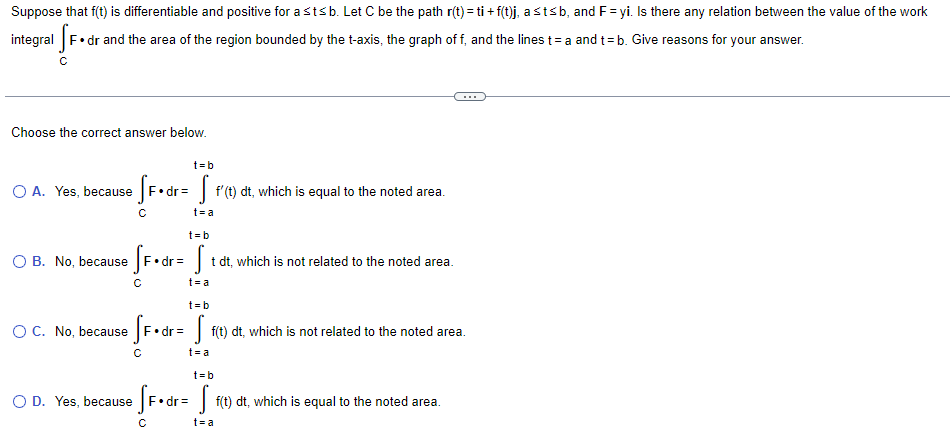Suppose that f(t) is differentiable and positive for a stsb. Let C be the path r(t) = ti + f(t)j, a ≤t≤ b, and F = yi. Is there any relation between the value of the work integral F. dr and the area of the region bounded by the t-axis, the graph of f, and the lines t= a and t= b. Give reasons for your answer. ISF. с Choose the correct answer below. t=b O A. Yes, because ·SF•dr= S f'(t) dt, which is equal to the noted area. с t=a t=b O B. No, because • fF.dr = f t dt, which is not related to the noted area. t=a t=b O C. No, because SF.dr = f(t) dt, which is not related to the noted area. C t=a t=b O D. Yes, because SF•dr= S f(t) dt, which is equal to the noted area. C t=a
Suppose that f(t) is differentiable and positive for a stsb. Let C be the path r(t) = ti + f(t)j, a ≤t≤ b, and F = yi. Is there any relation between the value of the work integral F. dr and the area of the region bounded by the t-axis, the graph of f, and the lines t= a and t= b. Give reasons for your answer. ISF. с Choose the correct answer below. t=b O A. Yes, because ·SF•dr= S f'(t) dt, which is equal to the noted area. с t=a t=b O B. No, because • fF.dr = f t dt, which is not related to the noted area. t=a t=b O C. No, because SF.dr = f(t) dt, which is not related to the noted area. C t=a t=b O D. Yes, because SF•dr= S f(t) dt, which is equal to the noted area. C t=a
Elements Of Modern Algebra
8th Edition
ISBN:9781285463230
Author:Gilbert, Linda, Jimmie
Publisher:Gilbert, Linda, Jimmie
Chapter5: Rings, Integral Domains, And Fields
Section5.4: Ordered Integral Domains
Problem 8E: If x and y are elements of an ordered integral domain D, prove the following inequalities. a....
Related questions
Question

Transcribed Image Text:Suppose that f(t) is differentiable and positive for a stsb. Let C be the path r(t) = ti + f(t)j, a ≤t≤ b, and F = yi. Is there any relation between the value of the work
integral F. dr and the area of the region bounded by the t-axis, the graph of f, and the lines t= a and t= b. Give reasons for your answer.
ISF.
с
Choose the correct answer below.
t=b
O A. Yes, because
·SF•dr= S f'(t) dt, which is equal to the noted area.
с
t=a
t=b
O B. No, because
• fF.dr = f t dt, which is not related to the noted area.
t=a
t=b
O C. No, because
SF.dr = f(t) dt, which is not related to the noted area.
C
t=a
t=b
O D. Yes, because
SF•dr= S f(t) dt, which is equal to the noted area.
C
t=a
Expert Solution
This question has been solved!
Explore an expertly crafted, step-by-step solution for a thorough understanding of key concepts.
Step by step
Solved in 2 steps with 2 images

Recommended textbooks for you

Elements Of Modern Algebra
Algebra
ISBN:
9781285463230
Author:
Gilbert, Linda, Jimmie
Publisher:
Cengage Learning,

Algebra & Trigonometry with Analytic Geometry
Algebra
ISBN:
9781133382119
Author:
Swokowski
Publisher:
Cengage

Elementary Linear Algebra (MindTap Course List)
Algebra
ISBN:
9781305658004
Author:
Ron Larson
Publisher:
Cengage Learning

Elements Of Modern Algebra
Algebra
ISBN:
9781285463230
Author:
Gilbert, Linda, Jimmie
Publisher:
Cengage Learning,

Algebra & Trigonometry with Analytic Geometry
Algebra
ISBN:
9781133382119
Author:
Swokowski
Publisher:
Cengage

Elementary Linear Algebra (MindTap Course List)
Algebra
ISBN:
9781305658004
Author:
Ron Larson
Publisher:
Cengage Learning